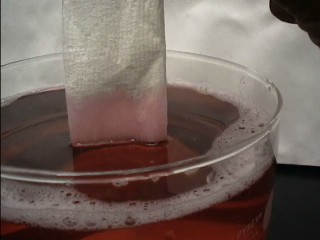10) Special Interfaces
(i) Wetting of porous media
-The wetting of porous media describes the properties of another category of very rough surfaces, albeit with a new twist. The three dimensional nature of the roughness gives rise to the phenomenon of impregnation. A drop placed on a porous medium does not merely spread on the surface but also penetrates the depth of support, thereby modifying its wetting properties. A liquid film deposited on a porous substrate recedes via two separate mechanisms: suction and dewetting. This topic encompasses the wetting of powders, rocks, and soils, and the paper industry.
Capillary rise in a porous medium
 |
If we take a piece of blotting paper and dip its end into water, the water promptly ascends, because the blotting paper has a lower surface energy when wet. In technical jargon, we express this by saying:
γsv > γsl
The rise of the liquid will eventually stop at a certain height h. The capillary forces pull the liquid up, whereas the gravity pulls it down.
Practical consequences
(i) Candle wicking
 http://www.easternchristian.com |
In taper candles the wick is the structure which supports
the first layers of wax that create the candle. In all candles it acts
as a fuel pump, supplying liquefied wax up to the top where all of the
action takes place (see the principle above). As a regulator, different
size wicks allow different amounts of wax up into the combustion area
providing different size flames. The wick is pretty much the most important
element of a candle. For more information about how a candle works, click
here. |
(ii) Inkjet droplet deposition
Surfactants are added to adjust the surface tension of the resultant ink. If the surface tension of an ink is too high, the ink may not wet (or travel) through the cartridge correctly. Sporadic printing may occur under some high use conditions. A high surface tension also may cause the ink to not wet ' out (or penetrate) the substrate effectively, resulting in uneven prints and longer dry times. If the surface tension of an ink is too low, it could drip out of the cartridge and cause flooding of the print head at the orifices during use. Low surface tension can also cause the print to wick or feather excessively on certain substrates and as a result the character will be fuzzy. So, the surfactant must work in combination with the penetrant or fixative. The ink must travel out of the cartridge effectively and print evenly. Once on the substrate, it must be absorbed into the material quickly to adhere and reduce dry time but not so fast that it goes through the paper or feathers excessively
Click here to find more information about role of surface tension in inkjet printing
Back to index ||Introduction to surface tension ||Definition of surface tension||Interfacial tension ||Minimal surfaces ||Soap bubbles, Surfactants and Detergents
Wettability||Role of roughness ||Capillarity and gravity||Dynamical effects and instability||Special interfaces ||Current research in wettability
Back to NIRT Home||On our current research ||More on Wetting||Contact Angle Measurement||Atomic Force Microscopy ||My personal homepage